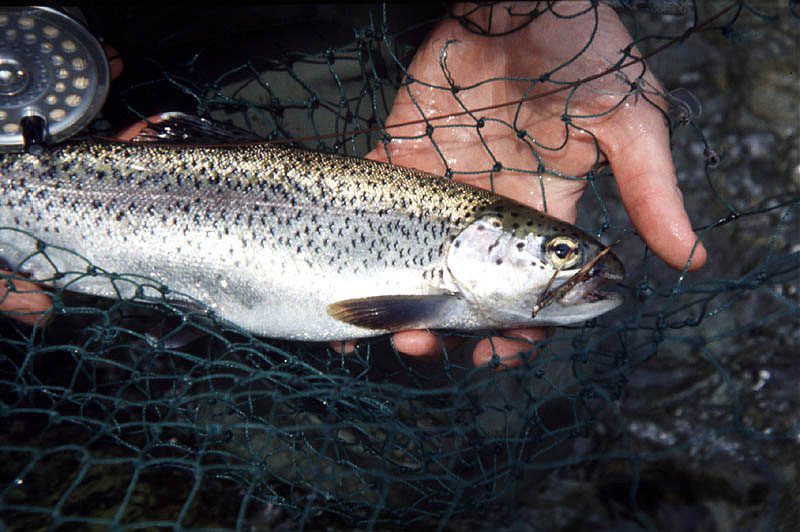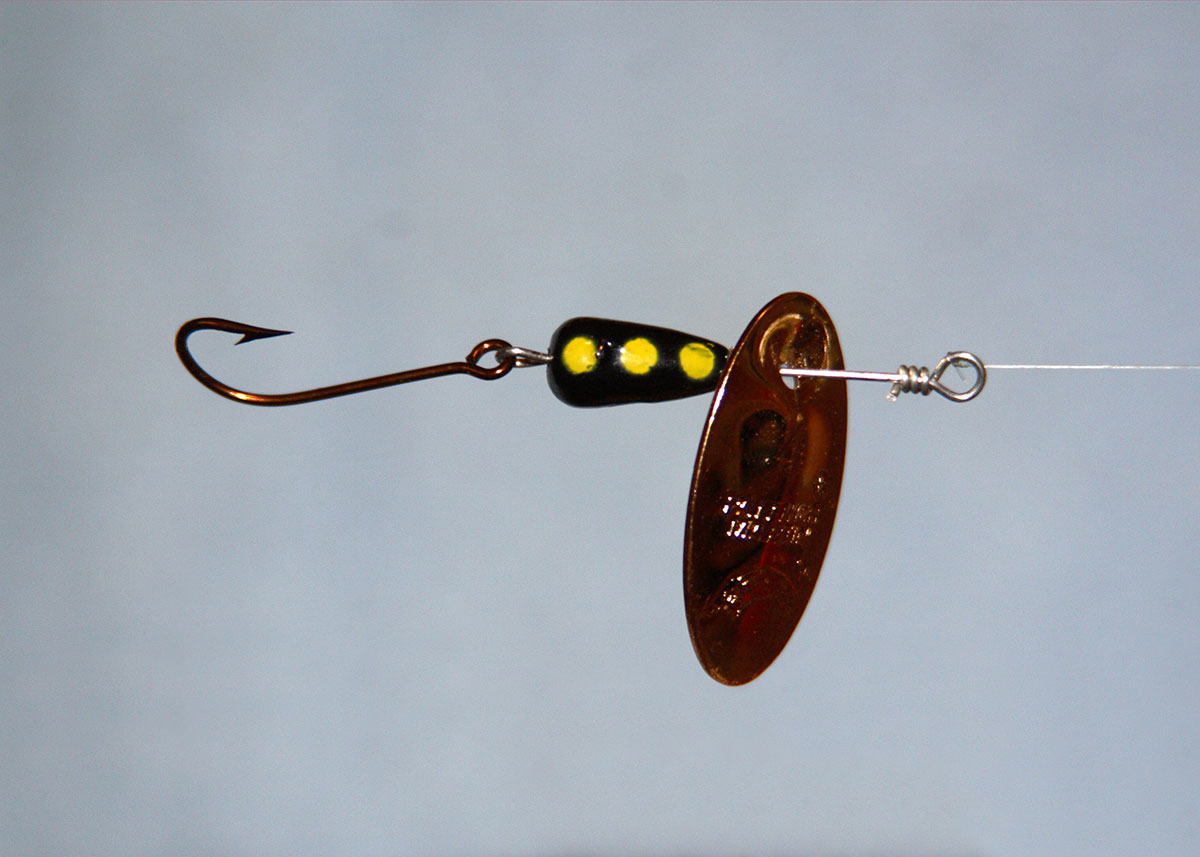Fishing for Cutthroat Trout
Cutthroat trout are the Pacific Northwest’s true native trout. It’s a survivor, having been here for many centuries. It’s a beautiful fish and a prime target for sport fishers. Cutthroat trout are highly adaptable and inhabit all kinds of aquatic environments from freshwater streams and lakes to tea colored seep lakes, beaver ponds and oxbow lakes. They are also anadromous; running to the sea where possible where they cruise the shorelines of brackish estuaries and beaches near the river mouths. They still inhabit much of their original territory, although in lower numbers.
“See-food diet” is a term that is often used by anglers of the Pacific Northwest to describe the feeding habits of the cutthroat trout. If they see food, they eat it. Yet this isn’t as true as it claims to be.
Many years ago, when the cutthroats were profuse throughout the Pacific Northwest, anglers would catch these trout in huge quantities. Often, these fish would fall prey to just about anything an angler could tie on a line. This feeding habit, unfortunately, turned out to be the cutthroats’ bane. They were so easy to catch that the populations plummeted due to over-fishing as well as loss of habitat.

Today the cutthroat has been recognized as needing a helping hand, and restocking programs are meeting with some success. Lucky for us that they are; it would be a shame to lose this beautiful native Northwesterner through our own greed, stupidity and ignorance.
Cutthroat Trout vs. Rainbow Trout
The cutthroat is a beautiful trout, easily distinguishable from its cousin the rainbow trout. All cutthroats have large mouths and a maxillary that extends back past the back of the eye. Rainbows have smaller mouths and their maxillary does not extend that far. Cutthroats are heavily spotted with small black spots covering the majority of their flanks, often right to the belly. Rainbows’ spots seldom extend past the midpoint of the flank. Cutthroats in coastal waters, both fresh and salt, are very silver in color, whereas the interior (Westslope) cutthroats have more of a yellow hue to their body. The most easily recognizable characteristic of the cutthroat, however, is the red-orange slashes beneath the lower jaw; rainbows show no such attribute.
Rainbows and cutthroats are true trout and very close relatives. They both spawn in the spring and, where they occupy the same waters, they often hybridize to produce a cutt-bow. The cutt-bow shows characteristics of both species. It has a slightly smaller mouth than a true cutthroat, fewer spots, but still shows a faint red slash under the lower jaw. It also shows well known light pink stripe down the sides so characteristic of the rainbow trout.

Cutthroats as a rule like big meals and their preferred diet consists of salmon fry, sculpins, stickleback, and smaller trout. In waters that don’t contain these big morsels they survive on the usual trout fare of chironomids, leeches, and various nymphs and adult insects. They are a true opportunist and will often take a big offering even during a hatch of other insects, yet they can sometimes be as selective a quarry as any other fish.
Cutthroats in the coastal lakes most closely deserve their “see-food” diet label. With the variety of food available in lakes they are the least selective of the cutthroats. Spring brings with it the midge hatches and these trout key in on them, especially the smaller trout up to about 14 inches in length. Chironomid fishing for cutthroats can be exceptional at this time, but it can be a bit of a tough fish for the spin-casters. If the lake has feeder streams that are actively spawned in by salmon, cutthroats will school near the mouths of these creeks in the spring and wait for the fry to migrate into the lake, often moving right into the stream’s lower reaches in pursuit of fry. Fishing a fry pattern or a small silver spinner across the drop-off at a creek mouth during the fry migration is deadly and is one of the most productive ways of angling for these trout. Throughout the season, lake-dwelling cutthroats find a leech pattern or stickleback hard to resist and a black woolly bugger, black and silver flatfish, or black and silver Panther Martin fished deep and slow has been the demise of more cutthroats than I care to mention.

Where to find Cutthroat Trout
These trout have a habit of finding their way into some very unusual spots and once there they tend to grow quite large if left unmolested. A perfect example is a small sphagnum bog near my home. The open-water portion of this little spot is maybe 80 yards across in all directions. It is a remnant left over from the days when the local river used to flow through the area. The river has long since moved to another course, but the oxbow developed into a bog in its stead. Private lots surround the spot and access is severely restricted. The trout, however, pay that no mind. In my younger days I used to wander my way down there in my gumboots with my spinning rod in hand and cast a small yellow and red Panther Martin into the brown waters of the bog. Every second or third cast produced a cutthroat that was bright silver, full of scrap, and best of all, about two pounds in weight. I must have tangled every second or third fish in the roots and moss that floated along the shore of the little pond, but a long pole with the net tied to it usually solved the problem.
Beaver ponds and bogs often support populations of coastal cutthroats and it is certainly worth your while to check them out. Most anglers pass them by without a second thought and the trout are left alone to feed and grow. Without being exposed to lures or flies, these fish are suckers for the first imitation to be offered to them. Stickleback patterns are deadly in tea-colored waters such as these, as are small silver spinners. With flies especially, cast towards the shore laying your fly right up tight against the subsurface branches and weeds and retrieve with a short strip retrieve. Remember you are imitating a baitfish that moves in small short bursts of speed and the stops for a bit. Deadly.

What to use to catch Cutthroat Trout
Stream-dwelling cutthroats are another story. These trout can be so selective it drives even the most patient of anglers crazy. The smaller cutthroats will feed much like a rainbow, selectively taking nymphs and adult insects as the hatches present themselves throughout the season. Larger cutthroats, however, often ignore the hatches in preference of the sculpins, fry, and minnows. Fly patterns such as the muddler minnow, rolled muddler, and Mickey Finn, or lures like the Mepps silver spinners or brighter Panther Martins are the bane of these fish. During the autumn when the salmon move into the rivers and streams to spawn, the cutthroats lie a few feet behind them waiting for the odd errant egg to drift by. These trout can sometimes be seen actually banging into the sides of salmon to try and jar eggs from the pregnant hens. Simple single egg patterns tied from chenille, small craft pom-poms, or small gooey-bobs bounced right along the bottom through holding water work extremely well during the salmon spawn and the cutthroats will often take them with abandon.

Sea-run (anadromous) cutthroats are the most mysterious and most admired of the cutthroat trout. Early spring will find the sea-runs in the very lower reaches of the rivers and streams feeding actively on the migrating salmon fry. Any minnow pattern tied to imitate the species of fry that is migrating will take these fish then. The trout are aggressive at these times and hit hard. As the fry move out into the estuaries and oceans the trout follow.

Beach fishing for sea-runs is a great way to fish for these trout. While catching them can be difficult, finding them is the greatest challenge. Ocean-going cutthroats prefer shorelines of cobble and barnacles. Sandy shores seldom provide enough of the right forage to support them. Beaches near creek mouths that have rocky bottoms are the best, especially if structures such as old pilings and docks are nearby. Here the trout find needlefish and fry in amongst the rocks and floating debris and the trout utilize the structures for protection as well. Fly patterns such as the Mickey Finn, rolled muddler, and Professor, or lures like the Panther Martins and Mepps spinners that contain yellow or gold hues are especially effective for sea-runs.

To effectively fish sea-runs the fly-fisher needs nothing more than a dry line or intermediate 5 or 6 weight sinking line and a few of the patterns I mentioned above. Long casts and quick retrieves are the norm. The quick strip retrieve is important to remember. Since these trout prey on minnows and fry they expect their prey to be moving quickly to try to escape. Strip your fly quickly and maintain that speed. Sometimes a trout will follow the fly a good distance, often creating a slight wake behind it if the water is shallow. It’s hard to maintain your composure when this occurs, but if you alter your retrieve almost invariably the fish will refuse the fly and turn away. A steady quick strip will often convince the trout that this is as fast as the fly can go, or it hasn’t “seen” the predator yet and the trout will gobble it up before the fly tries to escape.

Yes, the cutthroat trout is a true Northwesterner. From the crystal-clear waters of the high alpine lakes to the murky depths of the sphagnum bogs it lives, and if given the chance, thrives. Its adaptability and “see-food” diet have enabled it to survive the by-products of human progress such as urban sprawl, pollution, and over-fishing. To continue its survival, all it needs is a chance. The future of the cutthroat is still in doubt, but at least there appears to be some light at the end of the tunnel. The state and provincial fisheries management programs have recognized the cutthroat’s plight and are working to ensure its survival through a combination of restocking programs and barbless hook/catch and release regulations.
Cutthroats provide Northwest anglers with a wide array of opportunities year-round. To continue to do so they require our help. Do them, and yourself, a favor and release the cutthroats you catch. Of all the gamefish on the coast they are the most vulnerable. Their numbers have been severely depleted over the past half-century, yet they continue to provide us with immense enjoyment . . . they deserve to be allowed to survive.





5 Comments
sz6al5
?
vbpkjr
g81s4d
0z8uys